Android Wear vs Pebble Steel: Smartwatch Face-Off
We pit two Android Wear smartwatches -- the LG G Watch and Samsung Gear Live -- against the Pebble Steel to help you make the best choice.


Are you ready for a smartwatch? A good one should deliver notifications and handy apps right to your wrist, so you can stare at your phone less and enjoy life more. It should also look like something you want to wear every day. Android Wear is Google’s attempt to make a splash in a still very young category. Sporting color touch screens, voice recognition and the smarts of Google Now, the first two Android Wear watches are the LG G Watch ($229) and the Samsung Gear Live ($199).
But these two devices have a formidable foe in the Pebble Steel ($229), which features a power-sipping, e-paper display along with a legion of apps. Plus, the Steel works with both iOS and Android phones. So should you go the Android Wear route or pick up a Pebble? We put all three devices through an eight-round face-off to help you make the best choice.
Design
The Pebble Steel is one of the most beautiful smartwatches on the market. And that's primarily because it looks more like a watch than a sci-fi movie prop. Its elegantly styled stainless steel body sports polished edges and a subtle Pebble logo. On the Steel’s right side are its up, select and down buttons. On its left side are the watch's back button and charging port.

Measuring 1.5 x 1.4 x 0.4 inches and weighing just 2 ounces, the Steel fits comfortably on both men's and women's wrists. With each watch you buy, Pebble includes both a leather and steel band, so you can mix it up depending on your mood.
MORE: Pebble Steel Reviewed: Elegant Design, Intuitive App Store
For its G Watch, LG took a less-is-more design approach. The watch's rectangular body is a combination of stainless steel and polycarbonate that's attractive in its simplicity. Still, you're unlikely to wear the G Watch to any black-tie events. Unlike the Pebble, there are no buttons on the G Watch. Instead, you navigate solely by its touch screen. Though it's roughly the same size as the Pebble Steel, the 1.8 x 1.5 x 0.39-inch G watch weighs less than the Steel, at just 1.3 ounces. We found the LG's rubberized wristband to be extremely comfortable, though it's not nearly as classy as the Steel's leather strap.

Samsung's Gear Live is essentially one of the company's Gear 2 Neos running Android Wear. The watch's bold look is certainly an attention grabber, but it's definitely not for everyone. Up front, the Live's touch screen display is surrounded by gaudy chrome accenting.
Get instant access to breaking news, the hottest reviews, great deals and helpful tips.
MORE: LG G Watch Review: Sleek, But Too Much Swiping

Measuring 2.2 x 1.5 x 0.35 inches, the Gear Live is a bit large for our taste. Our biggest complaint about design is its wristband. Rather than using a traditional clasp, the Live has two nubs that you press into the strap's holes. It's uncomfortable to put on and doesn't feel nearly as secure as a traditional watchband.
Winner: Pebble Steel. The Pebble Steel is the only watch of the three that doesn't look like it came from an episode of "The Jetsons," making it the winner of this match by a long shot.
Display
The Pebble Steel's standout feature is its monochromatic e-paper display, which gives the watch a cool retro look. And although it's not nearly as sharp as the screens found on the G Watch and Gear Live, the Pebble's display is incredibly easy to read in direct sunlight. Thanks to its motion-sensitive backlight, you can read the Pebble in the dark without issue.
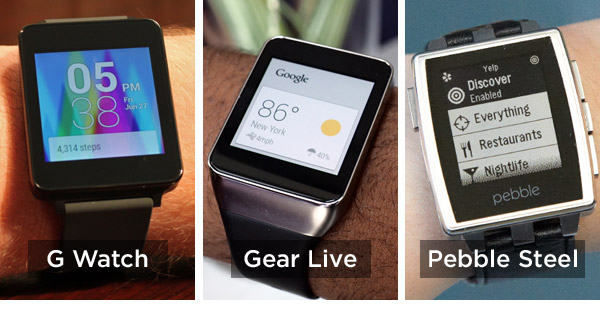
Of the three watches, the Gear Live's 1.63-inch, 320 x 320 Super AMOLED display offers the highest resolution. And next to the G Watch, Samsung’s watch produces far more vibrant colors. Both the Gear Live and G Watch feature an always-on display that dims when you're not using it. Unfortunately, the screen is practically impossible to see in direct sunlight when dimmed. And even when the display is active, you'll have to pump up its brightness to the max setting to even see it outdoors.
MORE: Samsung Gear Live Review: Is Android Wear Ready?
At 1.65 inches, the LG G Watch packs the largest display of this group. And while the 280 x 280 LCD touch screen is relatively sharp, colors looked paler than those viewed on the Gear Live. Like the Live, though, the G Watch's screen is virtually unreadable when dimmed and viewed in direct sunlight.
Winner: Pebble Steel. Of the two Android Wear watches, Samsung’s AMOLED screen is better, but only the Pebble Steel’s display is easy to read in sunlight.
Interface
The Pebble Steel's proprietary interface is fairly basic, but fairly easy to use. Up front are your customizable watch faces, which you can scroll through by pressing the up or down button on the watch's right side. Pushing the select button brings you to the watch's home screen. From here you can jump into the watch's music controller, notifications page, Alarms menu, available watch faces, settings and any of the up to eight apps you've downloaded.
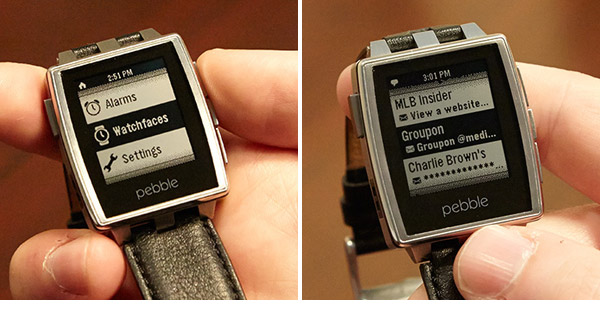
However, the interface requires a lot of button presses to navigate, which can be a chore. We do like that the Steel displays the time in every screen.
Both the Gear Live and G Watch run Google's Android Wear OS, which itself is essentially a modified version of Google Now. You get a series of cards arranged in a vertical list based on what Android Wear thinks is most relevant to you, according to the time of day and your location. Cards include Commute, Flights, Fitness, Keep, Navigation, Next Appointment, Music Control, Reminders and Voice Search.
MORE: Best Smartwatches
Android Wear prioritizes notifications for things like texts, instant messages and missed calls, putting those cards above any others. Information for each card is sucked in from Google's various services as well as your phone's notifications drawer.
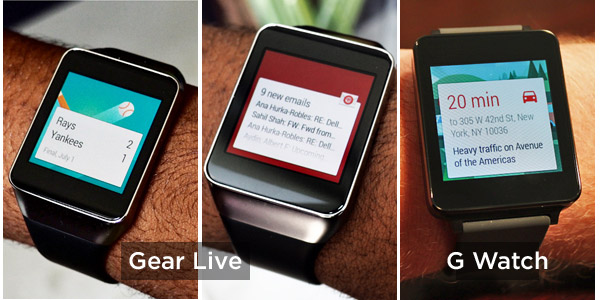
You navigate Android Wear by swiping up and down between cards. Swiping from right to left shows you more information about the card, while swiping left to right dismisses it. So if you have a Hangouts message, you can swipe to the left to view your conversation history, then swipe again to get to the Reply button. From there you can tap Reply and can either respond by using Google Voice or send a canned reply. If that sounds like a lot of swiping just to send a quick reply, it is.
Dismissing cards clears them from your list entirely, which can be incredibly annoying, especially if you want to view something again. Get rid of the Gmail card, for example, and you won't be able to view the message again.
Winner: Draw. Neither the Pebble Steel nor Android Wear offers very elegant interfaces, but the Pebble is a bit easier to navigate. That said, we appreciate that Android Wear supports touch input and that it lets you respond to messages.
Notifications
The Pebble Steel receives notifications from a host of sources, including calendar reminders, Facebook, Google Hangouts, Gmail, Google Voice, instant messages, phone calls and texts. Unfortunately, Android phone owners can't receive previews for Outlook messages, though iOS users can.
Notifications, which cause the Steel to vibrate and light up, can be managed through either the Pebble app on your phone or from the watch itself. From the app you can turn on and off all notifications or third-party notifications, and set whether you receive notifications for incoming calls and texts, calendar reminders, emails and other apps.

One of the best features of the Pebble Steel is that it saves your last 50 notifications no matter what source they came from. So you can pop into the notifications menu on the Steel and scroll through your texts, emails and instant messages. It's an excellent feature and more than enough to make the Steel worth owning. The one downside to the Steel is that you can't reply to any of your notifications from the watch.
Notifications received by Android Wear light up the watch's display and cause it to vibrate. Notifications include everything that can be displayed in your Android phone's notifications drawer. And while you can receive message previews for everything from Facebook and Twitter to Gmail and even ESPN ScoreCenter, you can't get text message previews unless you tie SMS messages to your Google Hangouts account.
MORE: 10 Ugliest Wearable Devices
Unfortunately, when you dismiss a notification in Android Wear, you can't get it back. On the plus side, when you dismiss a notification from your smartphone, it also disappears from your watch. What's more, you can reply to certain notifications on your Android Wear device from Gmail and Hangouts using either Google Voice to send a custom response or one of a handful of canned responses. You can't, though, send replies to messages from Facebook, Twitter or even Google+.
Winner: Pebble Steel. Android Wear can receive notifications for everything from text messages to sports scores, but the Pebble Steel wins this category by virtue of the fact that it saves your last 50 messages. Dismiss a notification in Android Wear and it's gone.
Apps
Pebble has its own curated app store that's accessible through the Pebble smartphone app for iOS and Android. And it's that app store that makes the Pebble Steel so appealing. With roughly 3,200 apps available for download and a lively developer community, you'll likely find almost any app you can think of.
MORE: 10 Best Pebble Apps
App categories available in the Pebble App Store include Daily, Games, Health & Fitness, Notifications, Remotes and Tools & Utilities. The app store also provides you with lists of the most popular apps, essentials and top picks to help make finding new apps easier.

Android Wear has the power of Google's Android community behind it, which should give it a leg up on the Pebble App Store in the long run. For now, though, there are only 35 apps optimized for Android Wear. So far, the biggest apps available for Wear include Pinterest, Maps, Hangouts, IFTTT, Lyft and Runtastic. Other highlights include Evernote Wear, which lets you take voice notes on the go, and Eat24, which lets you order food from your watch.
Winner: Pebble Steel. The Pebble Steel offers more than 3,200 smartwatch and companion apps, which blows away Android Wear's 35 apps. Over time, though, we expect Android Wear to overtake Pebble.
Fitness
The Pebble Steel doesn't come with any built-in fitness tracking sensors, but instead relies on developers and your smartphone to create fitness apps. Apps like Runtastic and Misfit offer step tracking, calories burned and a host of other information, while letting you control the timers and pace settings from the Pebble.

Because the Pebble is water-resistant, you can even take it to the pool and track your lap time, or bring it to the beach and wear it while surfing. What's more, many of these apps don't need to be within range of your smartphone to work, so you can leave them safely at home and sync all of your data with your phone later on.

Unlike the Steel, the G Watch has a built-in pedometer that you don't need your smartphone to use. The Gear Live goes a step further by adding a built-in heart rate monitor, which works with any compatible app.
MORE: Best Fitness Trackers
Android Wear's apps library is still extremely small, so there isn't much in terms of fitness options. But it’s nice to see RunKeeper and Runtastic in the Android Wear mix.
Winner: Android Wear (Gear Live). The Steel benefits from a larger fitness app selection, but with the Samsung Gear Live, you can track your fitness without always having to have your smartphone with you.
Special Features
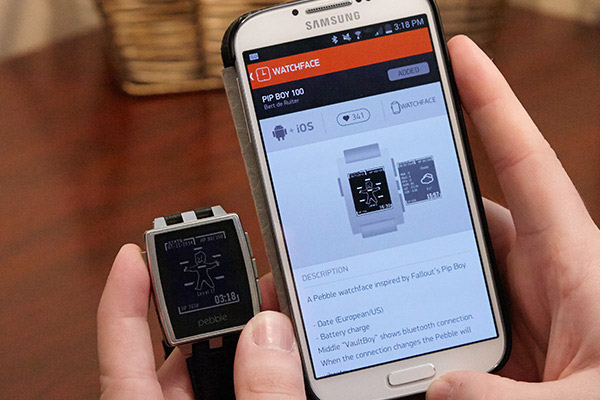
Of all of the Pebble's features, its best is easily its lively developer community. Pebble's developers not only offer slick apps, but they also update them regularly. Better still, they've created a smorgasbord of custom watch faces that give your watch its own unique personality. We're talking about everything from Super Mario to the infamous Heisenberg sketch from "Breaking Bad."
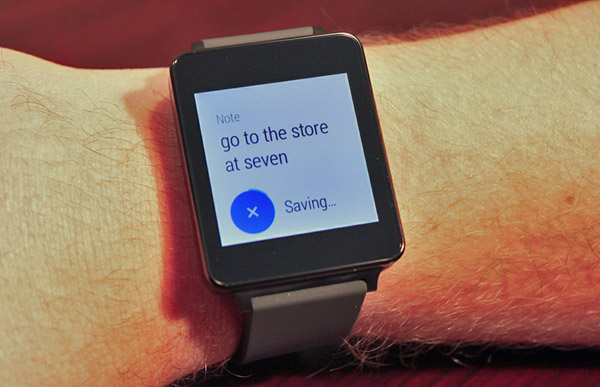
Android Wear is still very much in its infancy, but it already has a killer special feature with its voice search and recognition. Say “OK Google” or tap the face of the G Watch or Gear Live once and you can immediately begin using your voice to search the Web for answers to the universe's most vexing questions, like, "How many top-ten songs does Ke$ha have?" (The answer to that should be none, by the way.)
MORE: Why Apple's iWatch Already Beats Android Wear (Op-Ed)
On the more practical side, you can use your voice to take notes, set reminders, set your alarm, get turn-by-turn directions and more.
Winner: Android Wear. Pebble's developer community may be strong, but Android Wear's voice functionality lets you control nearly every aspect of your watch as well as perform Web searches.
Battery Life
Not a fan of charging your watch every day? The Pebble Steel has you covered. The Steel's lithium-ion polymer battery is rated to last a whopping five to seven days on a single charge, and based on our experience that's accurate.

We started using the watch on a Monday with a full charge and by Wednesday the Steel’s battery was only down to 50 percent. And that was with heavy use. The watch's impressive battery life is attributable to its low-power e-ink display.
The LG G Watch packs a 400-mAh battery that LG says will last just a single day on a charge. That means if you're on a business trip and you forget your charger at home, the G Watch turns into nothing more than an expensive bracelet. We used the watch for about eight hours, then left it on while we went to sleep and kept using it for another five hours before it told us that it was down to 20 percent battery life.
The Gear Live draws its power from a slightly smaller battery than the G Watch. Like the LG, the Samsung offers a day of battery life. We started using the watch early in the morning and it ran until about 10 p.m. before notifying us that it needed to be charged.
Winner: Pebble Steel. No contest here.
Bottom Line
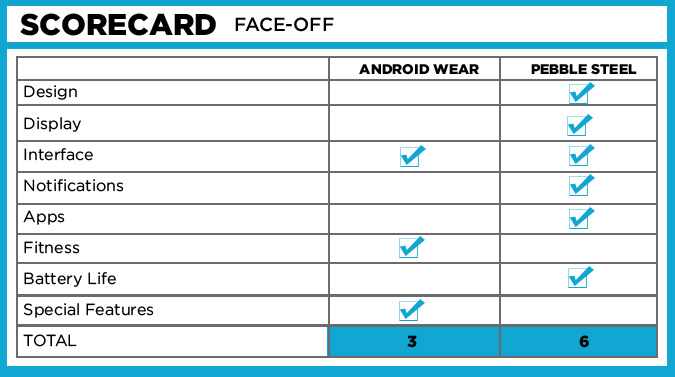
After eight rounds of battle, the Pebble Steel comes out on top. The Steel is more stylish than either Android Wear device, it’s much easier for users to read its display outdoors and it offers a wider selection of apps (although you can only store eight at once on the watch). Most important of all, the Steel lasts days longer on a charge.
Android Wear does some things better. The watches have color touch screens, and they deliver not just alerts but also notifications based on what you’re doing and where you’re going. Google’s platform takes full advantage of Google Now’s contextual intelligence. We also appreciate its ability to conduct searches and perform other commands by voice.
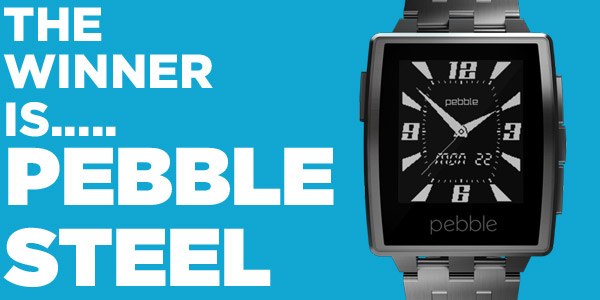
To be fair, Android Wear is brand spanking new, and will likely improve as more apps are added and developers learn how to exploit the platform. But right now the Pebble Steel is the smartwatch that we would buy.
- 15 Best Fitness Apps
- Why Wearable Tech Is Still Behind the Times
- Google Glass: What It Is and How It Works
Follow Daniel Howley @DanielHowley and on Google+. Follow us @tomsguide, on Facebook and on Google+.
Dan Howley is a writer and editor whose work has appeared on Tom's Guide, Laptop Mag, CNN business, MSN, AOL, and more, covering smartphones, laptops, and wearables. He now works full time at Yahoo Finance, where he writes articles covering the tech and gaming industries. He lives in New York.
-
Coolio Tools Ridiculous assumptions made here are that Pebble is an eInk screen when it's nothing more than a low res LCD. It is by not means high quality and shouldn't really be on the list of Smartwatches with it's 3yr old technology.Reply
2nd Worse most ridiculous assumption is the misinformation out about Samsung and LG's screens being unreadable. But I know the reality is only Samsung's Gear Live gets mentioned the most often! .....why?
Because Wear OS is not as Optimized yet, as Samsung's Tizen Gear Smartwatches. Which improved battery life to within reach of Pebble's DEAD Colorless LCD screen. Yes Pebble is an always on screen. But you better not be using the Weather/Clock Widget or you'll be getting only 2.5 days with latest update!
Get Real... naturally you can't see the screen on an Amoled screen in Wear Dimmed mode in direct sunlight! Just wake up World and Kill all this Samsung Hate, just because they PWN Apple and every other smart device maker in sales right now!!! -
jinogungon @Coolio ToolsReply
Check your facts first before posting anything. Commenting without knowing anything only makes you look stupid and arrogant.
https://getpebble.com/discover
http://www.pcmag.com/article2/0,2817,2429049,00.asp
http://en.wikipedia.org/wiki/Electronic_paper#Wristwatches
The Pebble/Pebble Steel uses a low-res e-paper display. That's the same display used by Amazon's kindle. Also, the review said and I quote "Like the Live, though, the G Watch's screen is virtually unreadable when dimmed and viewed in direct sunlight." They didn't say it was impossible to read in all cases. You're the only one thinking that. And Samsung hate? There was no tough love or criticism of Samsung in the article. You're the only one who thinks that.
But on an unrelated topic Samsung's Touchwiz is ugly, bulky, and uber slow. And their phone designs are ugly and cheap. I say this together with many other people all over the world who have the same opinion. No device, no product is perfect. Each device has it's pros and cons. It's how the companies improve on those criticisms that reflect what you perceive as hate. For example Apple listened to criticism regarding the antennagate scandal of the iPhone 4 and improved it on the 4s and the 5. How about Samsung? Since the S3 many have criticized the ugly plastic, the home button and touchwiz. But did Samsung listen? The Galaxy S5 is your answer. Compare the S3 with the S5 and you see very subtle changes in the design.
http://cdn.gottabemobile.com/wp-content/uploads/2014/04/Samsung-Galaxy-S5-vs-Galaxy-S4-vs-Galaxy-S3-Display.jpg
READ UP. Get your facts straight first. Dumbass. -
jinogungon Samsung Design executive was asked to resign because of criticism of Samsung phone designs.Reply
http://www.reuters.com/article/2014/05/08/us-samsung-elec-design-idUSBREA4702I20140508?irpc=932&irpc=932
http://www.businessinsider.com/why-samsung-uses-plastic-2014-5
Samsung is being criticized for its design by everybody including other Samsung executives. Stop living in a world where everybody should love Samsung for their "great" phones. -
morrisdev After reading this, and many other articles, I ended up buying a Pebble Steel.Reply
I am extremely happy with it. Much more than I ever expected.
I think what really, truly, makes the difference is that pebble isn't trying to replace your phone. I'm on the bus with a kid on my lap, my watch gives a light buzz, I glance down and see it's an annoying client.... no digging around for my phone. I just ignore it. I'm in the shower, get a call from an important client... I get out and answer it.
It has actually cut down on my phone usage. In the past, if I checked my email on the phone, I can't help but answer it. However, I've found myself being very selective now about answering stuff on my phone. Important things are often left until I get to an actual computer, semi-important things qualify to pull my phone out of my pocket, and unimportant things can get ignored.
That's just the basic notifications. No apps at all.
Beyond the notifications, the screen is a huge seller for me. Maybe people are desperate for color, but I need to have visibility. I am outside a lot and a Gear isn't going to do it for me. Half the time I can't seem phone's screen in the sun. The Pebble is very very clear. Even underwater.... I was swimming in the bay this morning... no problem. Middle of the night, a quick flick of the wrist lights it up.
Seriously. Maybe it seems cheesy to some people, but until there is a color screen that can last for a week and be visible in bright sunlight, I'm not changing.
Anyway, the Pebble Steel is a really nice watch. I'd say that it's key feature is that it enhances your smartphone experience rather than trying to replace it.
-
morrisdev After reading this, and many other articles, I ended up buying a Pebble Steel.Reply
I am extremely happy with it. Much more than I ever expected.
I think what really, truly, makes the difference is that pebble isn't trying to replace your phone. I'm on the bus with a kid on my lap, my watch gives a light buzz, I glance down and see it's an annoying client.... no digging around for my phone. I just ignore it. I'm in the shower, get a call from an important client... I get out and answer it.
It has actually cut down on my phone usage. In the past, if I checked my email on the phone, I can't help but answer it. However, I've found myself being very selective now about answering stuff on my phone. Important things are often left until I get to an actual computer, semi-important things qualify to pull my phone out of my pocket, and unimportant things can get ignored.
That's just the basic notifications. No apps at all.
Beyond the notifications, the screen is a huge seller for me. Maybe people are desperate for color, but I need to have visibility. I am outside a lot and a Gear isn't going to do it for me. Half the time I can't seem phone's screen in the sun. The Pebble is very very clear. Even underwater.... I was swimming in the bay this morning... no problem. Middle of the night, a quick flick of the wrist lights it up.
Seriously. Maybe it seems cheesy to some people, but until there is a color screen that can last for a week and be visible in bright sunlight, I'm not changing.
Anyway, the Pebble Steel is a really nice watch. I'd say that it's key feature is that it enhances your smartphone experience rather than trying to replace it.
